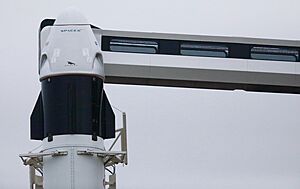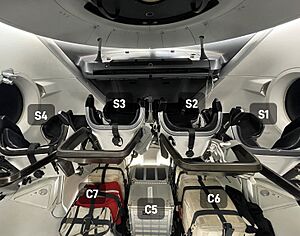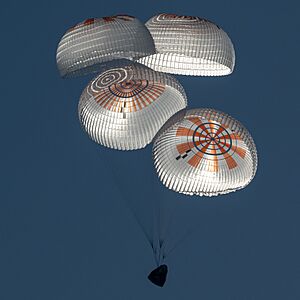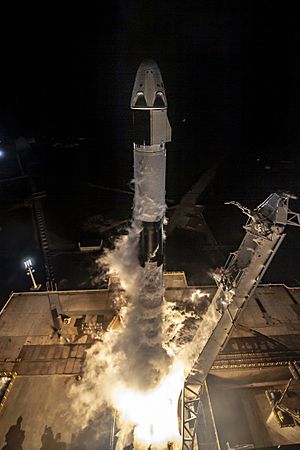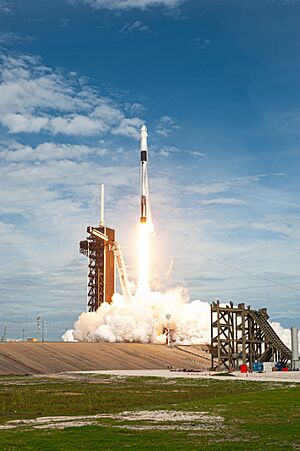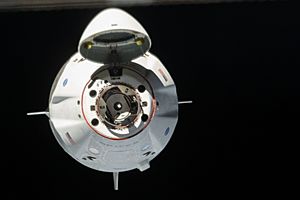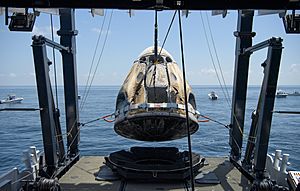SpaceX Dragon 2 facts for kids
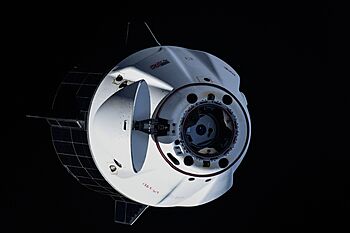
Crew Dragon C206 Endeavour approaching the ISS in May 2024 during Crew-8
|
|
| Manufacturer | SpaceX |
|---|---|
| Designer | SpaceX |
| Country of origin | United States |
| Operator | SpaceX |
| Applications | ISS crew and cargo transport; private spaceflight |
| Specifications | |
| Spacecraft type | Capsule |
| Design life |
|
| Launch mass | 27,600 lb (12,500 kg) |
| Dry mass | 16,976 lb (7,700 kg) |
| Payload capacity |
|
| Crew capacity |
|
| Volume |
|
| Power |
|
| Batteries | 4 × lithium polymer |
| Regime | Low Earth orbit |
| Dimensions | |
| Diameter | 4 m (13 ft) |
| Width | 3.7 m (12 ft) |
| Production | |
| Status | Active |
| Built | 13 (7 crew, 3 cargo, 3 prototypes) |
| Operational | 9 (5 crew, 3 cargo, 1 prototype) |
| Retired | 3 (1 crew, 2 prototypes) |
| Lost | 1 (crew, during uncrewed test) |
| Maiden launch |
|
| Related spacecraft | |
| Derived from | SpaceX Dragon 1 |
| Thruster details | |
| Propellant mass | 2,562 kg (5,648 lb) |
| Engines |
|
| Thrust |
|
| Specific impulse | Draco: 300 s (2.9 km/s) |
| Fuel | N 2O 4 / CH 6N 2 |
| Configuration | |
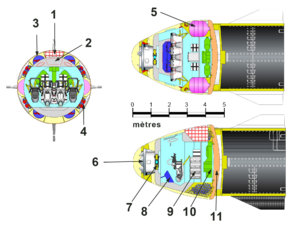 Cross-sectional views of the Crew Dragon 1: Parachutes, 2: Crew access hatch, 3: Draco thrusters, 4: SuperDraco engines, 5: Propellant tank, 6: IDSS port, 7: Port hatch, 8: Control panel, 9: Cargo pallet, 10: Environmental control system, 11: Heat shield |
|
The Dragon 2 is a special kind of spacecraft made by an American company called SpaceX. It's designed to be used more than once, which helps save money. This spacecraft flies to the International Space Station (ISS) and also takes part in private spaceflight missions.
The Dragon 2 has two main parts: a reusable capsule and a part called a "trunk" that is used only once. There are two versions of the Dragon 2:
- The Crew Dragon can carry up to four people.
- The Cargo Dragon carries supplies and is an improved version of the older Dragon 1 cargo capsule.
Both versions launch into space on a Falcon 9 Block 5 rocket. After their mission, the capsule part of the spacecraft returns to Earth by landing in the ocean.
The Crew Dragon's main job is to take astronauts to and from the ISS for NASA. Before this, the Space Shuttle did this job until it stopped flying in 2011. The Crew Dragon also flies private missions to the ISS and other places. It is expected to help transport people to a future space station planned by Axiom Space.
The Cargo Dragon delivers supplies to the ISS for NASA. It shares this job with another spacecraft called Cygnus. As of July 2025, the Cargo Dragon is the only reusable spacecraft that carries cargo to orbit. Another spacecraft, the Sierra Space Dream Chaser, is being developed and might join it in the future.
Contents
What are the Dragon 2 versions?
The Dragon 2 spacecraft comes in two main types: the Crew Dragon and the Cargo Dragon. The Crew Dragon was first called "DragonRider." It was always planned to carry people, or a mix of people and cargo.
Older spacecraft had to be pulled into place at the ISS by station crew. But the Dragon 2 has a special docking port that lets it connect directly to the ISS by itself. It can fly to the station and dock automatically, though astronauts can take control if needed. For most missions, the Crew Dragon stays connected to the ISS for about 180 days, but it can stay for up to 210 days.
All about the Crew Dragon
The Crew Dragon can fly on its own without constant control from Earth. SpaceX and NASA say it can carry seven astronauts. However, for regular missions, it usually carries two to four crew members. As of January 2025, it has never carried more than four people.
The Crew Dragon has a special safety system called a launch escape system. It uses eight powerful SuperDraco engines. These engines can quickly push the capsule away from the rocket if there's an emergency during launch. SpaceX first thought about using these engines to land the Crew Dragon on land. But now, the only way it lands is by splashing down in the ocean using parachutes.
Astronauts wear special space suits during launch and when they return to Earth. These suits keep them cool inside the Dragon. They also protect them if the cabin suddenly loses air pressure. The suits are made from a fire-resistant material called Nomex.
The design of the spacecraft was shown to the public in May 2014. In October 2014, NASA chose the Dragon spacecraft to fly American astronauts to the International Space Station. This was part of NASA's Commercial Crew Program. SpaceX has built several Crew Dragon capsules and continues to make parts for them. They also build a new trunk for each flight.
Each seat on a Crew Dragon flight for NASA costs around US$55 million. This was less expensive than the price NASA paid for seats on the Russian Soyuz spacecraft in 2014.
All about the Cargo Dragon
The Dragon 2 was designed from the start to carry either crew or cargo.
The cargo version, called Cargo Dragon, became a reality after 2014. NASA needed more ways to send supplies to the ISS. In January 2016, SpaceX won contracts for six of these cargo flights. As of April 2024, the Cargo Dragon has completed nine missions to and from the ISS, with six more planned.
Cargo Dragons are different from Crew Dragons. They don't have seats, controls for astronauts, or the special life support systems needed for people. They also don't have the SuperDraco abort engines. The Cargo Dragon is much better than the original Dragon for bringing things back to Earth and being reused.
Since 2021, the Cargo Dragon can even provide power to some experiments while it's docked to the ISS. This saves space and time for astronauts. This feature is called "Extend-the-Lab." For example, during the CRS-23 mission, three experiments used this feature. In November 2024, a Cargo Dragon even helped push the ISS higher in orbit using its thrusters.
What is the US Deorbit Vehicle?
The US Deorbit Vehicle is a planned version of the Cargo Dragon. It will be used to safely bring the ISS out of orbit when it's time to retire the station. This vehicle will attach to the ISS. It will have a longer trunk with 46 Draco thrusters (instead of the usual 16) and carry a lot more fuel. NASA plans to launch this vehicle in 2030. It will stay attached to the ISS for about a year as the station slowly loses altitude. Then, it will push the station into a remote part of the Pacific Ocean, known as the "spacecraft cemetery," where any remaining pieces will fall safely.
How is Dragon 2 designed?
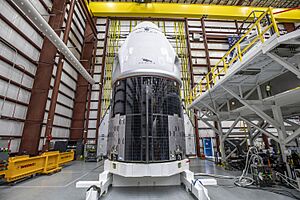
SpaceX wants to make space travel much cheaper. That's why they designed Dragon 2 to be reused instead of thrown away after one flight. It has two main parts: the capsule, which is reused, and the trunk, which is not.
SpaceX and NASA first said the capsule could be used for five missions. As of March 2024, they are working to allow it to fly up to fifteen missions.
To save costs, Dragon 2 has some clever features. The Crew Dragon uses eight SuperDraco engines on its sides for its emergency escape system. This means it doesn't need a separate, disposable escape tower. Also, important systems like life support, thrusters, and fuel tanks are built into the reusable capsule. This is different from other spacecraft that put these systems in a part that gets thrown away.
The trunk connects the capsule to the Falcon 9 rocket. It also holds solar panels to make electricity and a radiator to get rid of heat. Fins on the trunk help keep the spacecraft stable during emergency takeoffs. Unlike the older Dragon 1, the Dragon 2's solar panels are built right into the trunk. The trunk can also carry unpressurized cargo, like the Roll Out Solar Array that was taken to the ISS.
A typical Crew Dragon mission carries four astronauts. This includes a commander, a pilot, and two mission specialists. The commander leads the mission, and the pilot helps with operations. Mission specialists have specific jobs depending on the flight. However, the Crew Dragon can fly with just two astronauts if needed. In an emergency, up to seven astronauts could return to Earth from the ISS on a Dragon.
On the ground, crews get into the capsule through a side door.
Inside the Crew Dragon, above the two front seats, there's a control panel with three screens. Below the seats, there's a cargo area that can hold about 500 pounds of items. The capsule also has a small space toilet with a privacy curtain. The top of the capsule has a special port to connect to the ISS. For private missions that don't go to the ISS, this port can be replaced with a large, clear window for amazing views. SpaceX has also made a special hatch for spacewalks.
The Cargo Dragon is also loaded through a side door and has a docking port. However, it doesn't have the control panels, windows, or seats found in the Crew Dragon.
The spacecraft can work in the complete emptiness of space. Astronauts wear their SpaceX-designed space suits to protect them if the cabin suddenly loses air pressure. The spacecraft is also designed to land safely even if it has a small leak.
The nose cone of the spacecraft protects the docking port and four front-facing thrusters during launch and reentry. This cone opens up when the spacecraft is in space. The Dragon 2's fuel and helium gas for emergency takeoffs and moving around in orbit are stored in special tanks at the bottom of the capsule.
For emergency takeoffs, the capsule uses eight SuperDraco engines. Each engine is very powerful. Sixteen smaller Draco thrusters around the spacecraft help it control its direction and move in orbit.
When the capsule returns to Earth, a special PICA-3 heat shield protects it from the extreme heat of reentry. The Dragon 2 uses six parachutes (two small ones and four main ones) to slow down before splashing into the ocean. This is one more parachute than the older Dragon 1 used. NASA required the extra parachute for safety after a problem with a Dragon 1 parachute. In 2024, the SuperDraco thrusters were enabled again for landing, but only as a backup if the parachutes have problems.
Who flies on Crew Dragon?

The Crew Dragon is used by both private companies and government agencies like NASA. Axiom Space flies private astronauts to the ISS and plans to fly them to their own private space station in the future. NASA flights to the ISS carry four astronauts, and the extra space is used for pressurized cargo.
On September 16, 2014, NASA announced that SpaceX and Boeing were chosen to provide crew transportation to the ISS. SpaceX received up to US$2.6 billion for this contract. This included test flights and up to six regular flights. The first operational flight of Crew Dragon, SpaceX Crew-1, happened on November 16, 2020, after several test flights.
Unlike in the past, where NASA directly operated spacecraft, NASA now buys space transportation services from SpaceX. This includes building, launching, and operating the Dragon 2.
NASA approved a new way to load fuel onto the Falcon 9 rocket. This rocket uses very cold fuel. Unlike older NASA spacecraft, where fuel was loaded hours before launch, on the Falcon 9, fuel is loaded just before launch. This keeps the fuel super cold. Fuel loading starts about 40 minutes before liftoff. The launch escape system is active during this time to make sure the crew can escape safely if there's an emergency.
The first test mission without a crew, called "Demo-1," launched to the International Space Station (ISS) on March 2, 2019. After some delays, the first flight with a crew, "Demo-2," launched on May 30, 2020.
How was Dragon 2 tested?
SpaceX planned four main tests for the Crew Dragon:
- A pad abort test (to see if it could escape from the launchpad).
- An uncrewed orbital flight to the ISS.
- An in-flight abort test (to see if it could escape during flight).
- Finally, a crewed flight to the ISS.
Pad abort test
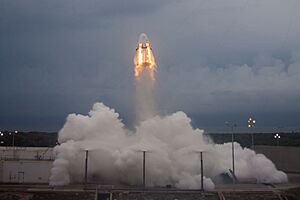
The pad abort test happened successfully on May 6, 2015. The Dragon capsule landed safely in the ocean about 99 seconds after its SuperDraco engines fired. For this test, a special crash test dummy with sensors was placed inside. This dummy helped record how much force the crew would feel. The test showed that the spacecraft could escape safely from the launchpad.
On November 24, 2015, SpaceX tested the Dragon 2's ability to hover. This test happened at their rocket development facility in McGregor, Texas. A video showed the spacecraft hovering for about 5 seconds, using its SuperDraco engines. The same capsule used for the pad abort test was used here; it was nicknamed DragonFly.
Demo-1: First orbital flight test
In 2015, NASA chose four experienced astronauts to work with SpaceX and Boeing. These astronauts were Robert Behnken, Eric Boe, Sunita Williams, and Douglas Hurley. The Demo-1 mission was a big step. It helped clear the way for commercial flights to the ISS. On August 3, 2018, NASA announced the crew for the next mission, DM-2. This crew included NASA astronauts Bob Behnken and Doug Hurley.
The first orbital test of Crew Dragon was an uncrewed mission called "Demo-1." It launched on March 2, 2019. The spacecraft practiced flying to and docking with the ISS automatically. It stayed docked until March 8, 2019. Then, it returned to Earth, splashed down, and was recovered. This test helped make sure it was ready for a crewed mission. The same capsule was supposed to be used for an in-flight abort test later, but it was destroyed in an explosion on April 20, 2019.
Explosion during testing
On April 20, 2019, the Crew Dragon capsule used in the Demo-1 mission was destroyed. This happened during a ground test of its abort thrusters. The problem occurred when a small amount of fuel leaked into a helium line. This caused an explosion.
SpaceX changed the Dragon 2 design to fix this. They replaced certain valves with special "burst discs" that are used only once. They also added flaps to the SuperDraco engines to prevent water from getting in after splashdown. A new test of the SuperDraco engines on November 13, 2019, was successful, showing the changes worked.
Because the destroyed capsule was meant for the in-flight abort test, the explosion caused delays for that test and the first crewed flight.
In-flight abort test
The Crew Dragon in-flight abort test launched on January 19, 2020. The test showed that the Dragon 2 could safely separate from the Falcon 9 rocket during an emergency in flight. The Dragon 2 used its SuperDraco abort engines to push itself away from the rocket. The Falcon 9 rocket was then destroyed on purpose. The Dragon capsule then followed its path, dropped its trunk, and used its smaller Draco engines to get ready for descent. All parts of the test worked, including separation, engine firings, parachute deployment, and landing.
The Dragon 2 splashed down in the Atlantic Ocean. This test proved that the spacecraft could safely move away from the rocket even when the rocket was under the most stress during flight. This was the final test before the spacecraft started carrying astronauts to the International Space Station.
Demo-2: First crewed orbital flight
On April 17, 2020, NASA announced that the first crewed Crew Dragon Demo-2 mission to the International Space Station would launch on May 27, 2020. Astronauts Bob Behnken and Doug Hurley were the crew for this mission. This was the first time astronauts launched to the ISS from U.S. soil since July 2011. The launch was delayed to May 30, 2020, because of bad weather. The second launch attempt was successful. The capsule, named Endeavour by the crew, launched on May 30, 2020. It successfully docked with the International Space Station on May 31, 2020. On August 2, 2020, the Crew Dragon undocked and splashed down safely in the Atlantic Ocean.
Astronaut Bob Behnken described the launch as "smooth" but also like "riding a dragon." He said it felt "more 'alive'" than the Space Shuttle.
Behnken also talked about the descent back to Earth. He said, "Once we descended a little bit into the atmosphere, Dragon really came alive." He felt the spacecraft moving and heard the "rumble" of the atmosphere outside. He described the separation events, like the trunk separating and the parachutes opening, as feeling like "getting hit in the back of the chair with a baseball bat."
List of Dragon 2 spacecraft
| S/N | Name | Type | Status | Flights | Flight time | Total flight time | Notes | Cat. |
|---|---|---|---|---|---|---|---|---|
| C201 | DragonFly | Prototype | Retired | 1 | Error: Parameter show=s is not supported here (Pad Abort Test) | Error: Parameter show=s is not supported here | This prototype was used for the pad abort test and hover tests. | |
| C202 | None | Prototype | Retired | N/A | N/A | N/A | Used for testing the structure of the spacecraft. | |
| C203 | None | Prototype | In use | N/A | N/A | N/A | Used for testing the life support system. Still in use for human-in-the-loop testing. | |
| C204 | None | Crew | Destroyed | 1 | 6d 5h 56m (Demo-1) | 6d 5h 56m | The first Dragon 2 to fly in space. It was accidentally destroyed during ground testing after its flight. | |
| C205 | None | Crew | Retired | 1 | 8m 54s (In-Flight Abort Test) | 8m 54s | Used for the Crew Dragon In-Flight Abort Test and then retired. | |
| C206 | Endeavour | Crew | Active | 5 | 63d 23h 25m (Demo-2) | 701d 21h 16m | The first vehicle to carry a crew. It has flown five missions, including Crew Demo-2, Crew-2, Axiom-1, Crew-6, and Crew-8. It is scheduled to fly Crew-11. | |
| 199d 17h 44m (Crew-2) | ||||||||
| 17d 1h 49m (Axiom-1) | ||||||||
| 185d 22h 43m (Crew-6) | ||||||||
| 235d 3h 35m (Crew-8) | ||||||||
| C207 | Resilience | Crew | Active | 4 | 167d 6h 29m (Crew-1) | 178d 19h 17m | First flew on Crew-1. It has also flown private missions like Inspiration4, Polaris Dawn, and Fram2. | |
| 2d 23h 3m (Inspiration4) | ||||||||
| 4d 22h 13m (Polaris Dawn) | ||||||||
| 3d 14h 32m (Fram2) | ||||||||
| C208 | None | Cargo | Active | 5 | 38d 9h 8m (CRS-21) | 175d 13h 52m | The first Cargo Dragon 2. It has flown five missions, including CRS-21, CRS-23, CRS-25, CRS-28 and CRS-31. | |
| 32d 19h 42m (CRS-23) | ||||||||
| 36d 18h 8m (CRS-25) | ||||||||
| 24d 22h 43m (CRS-28) | ||||||||
| 42d 16h 10m (CRS-31) | ||||||||
| C209 | None | Cargo | Active | 5 | 36d 9h 59m (CRS-22) | 175d 23h 36m | The second Cargo Dragon 2. It has flown five missions, including CRS-22, CRS-24, CRS-27, CRS-30 and CRS-32. | |
| 34d 10h 57m (CRS-24) | ||||||||
| 31d 20h 28m (CRS-27) | ||||||||
| 24d 22h 43m (CRS-30) | ||||||||
| 33d 21h 29m (CRS-32) | ||||||||
| C210 | Endurance | Crew | Active (docked to ISS) |
4 | 176d 2h 39m (Crew-3) | 835 days, 7 hours, 38 minutes (currently in space) |
First flew on Crew-3. It has also flown Crew-5, Crew-7, and Crew-10. | |
| 157d 10h 1m (Crew-5) | ||||||||
| 199d 2h 20m (Crew-7) | ||||||||
| 302d 16h 38m (Crew-10, in progress) | ||||||||
| C211 | None | Cargo | Active | 2 | 45d 14h 58m (CRS-26) | 88d 7h 4m | The third Cargo Dragon 2. It has flown CRS-26 and CRS-29 missions. | |
| 42d 16h 5m (CRS-29) | ||||||||
| C212 | Freedom | Crew | Active | 4 | 170d 13h 2m (Crew-4) | 372d 14h 50m | First flew on Crew-4. It has also flown Axiom-2, Axiom-3, and Crew-9. | |
| 9d 5h 27m (Axiom-2) | ||||||||
| 21d 15h 40m (Axiom-3) | ||||||||
| 171d 4h 39m (Crew-9) | ||||||||
| C213 | Grace | Crew | Active | 1 | 20d 2h 59m (Axiom-4) | 20d 2h 59m | On its first flight with Axiom-4. |
List of Dragon 2 flights
This list includes missions that have already happened or are planned. Dates are in UTC.
Crew Dragon flights
| Mission and patch | Capsule | Launch date | Landing date | Launch pad | Landing site | What happened | Crew | Result |
|---|---|---|---|---|---|---|---|---|
| Pad Abort Test (patch) | C201 DragonFly | 6 May 2015 | SLC-40 | Atlantic Ocean | This test showed that the Crew Dragon's SuperDraco engines could lift the capsule away from the launchpad in an emergency. It landed safely in the ocean. | N/A | Success | |
| Demo-1 (patch) | C204 | 2 March 2019 | 8 March 2019 | LC-39A | Atlantic Ocean | This was a test flight without a crew. It successfully docked with the ISS. | N/A | Success |
| In-Flight Abort Test (patch) | C205 | 19 January 2020 | LC-39A | Atlantic Ocean | The booster was told to act like its engine failed. The Crew Dragon's SuperDraco engines fired and pushed the capsule safely away. | N/A | Success | |
Demo-2  |
C206‑1 Endeavour | 30 May 2020 | 2 August 2020 | LC-39A | Gulf of Mexico | This was the first test flight of Dragon 2 with a crew. The mission was made longer to help the ISS crew. | Success | |
| Crew-1 |
C207‑1 Resilience | 16 November 2020 | 2 May 2021 | LC-39A | Gulf of Mexico | This was the first regular flight for NASA's Commercial Crew program. | Success | |
| Crew-2 |
C206‑2 Endeavour | 23 April 2021 | 9 November 2021 | LC-39A | Gulf of Mexico | This was the first time a capsule and rocket booster were reused for a crewed mission. |
|
Success |
| Inspiration4 (patch 1 and 2) | C207‑2 Resilience | 16 September 2021 | 18 September 2021 | LC-39A | Atlantic Ocean | This was the first fully private flight with only civilians. The crew flew higher than the ISS and did science experiments for three days. It was the first flight with the special cupola window. |
|
Success |
Crew-3  |
C210‑1 Endurance | 11 November 2021 | 6 May 2022 | LC-39A | Gulf of Mexico |
|
Success | |
| Axiom-1 (patch) | C206‑3 Endeavour | 8 April 2022 | 25 April 2022 | LC-39A | Atlantic Ocean | This was the first fully private flight to the ISS. An Axiom Space employee commanded the mission with three private tourists. |
|
Success |
Crew-4  |
C212‑1 Freedom | 27 April 2022 | 14 October 2022 | LC-39A | Atlantic Ocean |
|
Success | |
Crew-5  |
C210‑2 Endurance | 5 October 2022 | 12 March 2023 | LC-39A | Gulf of Mexico | This crew included a Russian cosmonaut as part of a seat swap program. |
|
Success |
Crew-6  |
C206‑4 Endeavour | 2 March 2023 | 4 September 2023 | LC-39A | Atlantic Ocean | Success | ||
| Axiom-2 (patch) | C212‑2 Freedom | 21 May 2023 | 31 May 2023 | LC-39A | Gulf of Mexico | A fully private flight to the ISS. An Axiom employee commanded the mission, and other seats were bought by the Saudi Space Agency and a tourist. |
|
Success |
Crew-7  |
C210‑3 Endurance | 26 August 2023 | 12 March 2024 | LC-39A | Gulf of Mexico |
|
Success | |
| Axiom-3 (patch) | C212‑3 Freedom | 18 January 2024 | 9 February 2024 | LC-39A | Atlantic Ocean | A fully private flight to the ISS. An Axiom employee commanded the mission, and other seats were bought by different space agencies. |
|
Success |
Crew-8  |
C206‑5 Endeavour | 4 March 2024 | 25 October 2024 | LC-39A | Gulf of Mexico | This was the longest Crew Dragon mission. The ISS stay was extended. |
|
Success |
| Polaris Dawn (patch) | C207‑3 Resilience | 10 September 2024 | 15 September 2024 | LC-39A | Gulf of Mexico | A fully private orbital flight, including two SpaceX employees. It flew 1400 km away from Earth, the highest orbit for a crewed spacecraft since the Apollo program. The first commercial spacewalk happened during this mission. | Success | |
Crew-9  |
C212‑4 Freedom | 28 September 2024 | 18 March 2025 | SLC-40 | Gulf of Mexico | This was the first crewed mission to launch from SLC-40. It launched with two crew members and returned with the crew of the Boeing Crew Flight Test. |
|
Success |
| Crew-10 |
C210‑4 Endurance | 14 March 2025 | August 2025 | LC-39A | Pacific Ocean (planned) |
|
In progress | |
| Fram2 (patch) | C207‑4 Resilience | 1 April 2025 | 4 April 2025 | LC-39A | Pacific Ocean | A fully private, all-civilian orbital flight. This was the first crewed mission to fly over the Earth's poles. It was also the first crewed Dragon landing on the West Coast. | Success | |
| Axiom-4 (patch) | C213‑1 Grace | 25 June 2025 | 15 July 2025 | LC-39A | Pacific Ocean | A fully private flight to the ISS. An Axiom employee commanded the mission, and other seats were bought by different space agencies. |
|
Success |
Crew-11  |
C206‑6 Endeavour | 31 July 2025 | April 2026 | TBA | Pacific Ocean (planned) |
|
Planned | |
| Crew-12 | TBA | 31 March 2026 | October 2026 | TBA | Pacific Ocean (planned) |
|
Planned | |
| Axiom-5 | TBA | May 2026 | TBA | TBA | Pacific Ocean (planned) | A fully private flight to the ISS. | TBA | Planned |
| Vast-1 | TBA | June 2026 | TBA | TBA | Pacific Ocean (planned) | This mission will service the Haven-1 space station. | TBA | Planned |
| Crew-13 | TBA | TBA | TBA | TBA | Pacific Ocean (planned) | TBA | Planned | |
| Crew-14 | TBA | TBA | TBA | TBA | Pacific Ocean (planned) | TBA | Planned | |
| Polaris-2 | TBA | TBA | TBA | TBA | Pacific Ocean (planned) | This will be the last Polaris Program flight to use Crew Dragon. |
|
Planned |
Cargo Dragon flights
Timeline of Dragon 2 flights
The Crew Dragon has flown many missions for NASA and private companies. The Cargo Dragon has also flown many supply missions for NASA.

See also
 In Spanish: Dragon 2 para niños
In Spanish: Dragon 2 para niños
- Comparison of crewed space vehicles
- Comparison of space station cargo vehicles
- List of crewed spacecraft
- Crew Dragon Launch Abort System
- Private spaceflight



